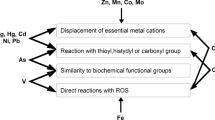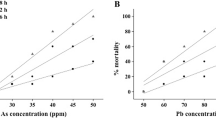Abstract
Hydrogen sulfide can both exert a toxic effect and function as a signaling molecule in various physiological processes. Under conditions of experimental short-term hydrogen sulfide loading (HSL), activities of oxidoreductases (enzymes of energy metabolism and antioxidant defense)—malate dehydrogenase (MDH, 1.1.1.37), lactate dehydrogenase (LDH, 1.1.1.27) and catalase (1.11.1.6) were analyzed in oxyphilic tissues (brain, heart, gills) of the Black Sea sea ruff Scorpaena porcus Linnaeus, 1758. Two groups of fish were exposed for 5 min to different concentrations of sodium sulfide (37 and 75 µM Na2S) used as a hydrogen sulfide donor. High MDH and LDH activities were simultaneously detected in the brain structures and heart chambers, reflecting a similar potential of energy metabolism in these tissues, while enhanced LDH activity in the brain indicated anaerobization of the energy metabolism pathways. Differences in oxydoreductase activities were found between the first and fourth branchial arches, heart atrium and ventricle, as well as between different brain compartments. Under HSL, the gills exhibited some signs of hypoxemia (increasing darkening of the lamellae as the Na2S concentration moved upward) and metabolic depression. At a low Na2S concentration, HSL did not cause significant changes in oxidoreductase activities in the brain and heart, while upon a 2-fold increase in the Na2S concentration these changes became more pronounced. In the key oxyphilic structures (anterior brain compartments, heart ventricle) intense HSL led to a simultaneous increase in LDH and MDH activities, which was due to the ability of MDH to participate in anaerobic processes. The less O2-sensitive structures (medulla oblongata and heart atrium) exhibited almost no changes in MDH and LDH activities even in response to high-intensity HSL, suggesting a different mode of energy metabolism in these tissues. Under intense HSL, the oxidoreductases in the heart ventricles and anterior brain compartments demonstrated responses, which were similar to those under hypoxia/anoxia.



Similar content being viewed by others
REFERENCES
Bagarinao, T. and Vetter, R.D., Sulphide tolerance and adaptation in the California killifish, Fundulus parvipinnis, a salt marsh resident, J. Fish Biol., 1993, vol. 42(5), pp. 729–748. doi: 10.1111/j.1095-8649.1993.tb00381.x
Torrans, E.L. and Clemens, H.P., Physiological and biochemical effects of acute exposure of fish to hydrogen sulfide, Comp. Biochem. Physiol., 1982, vol. 71(2), pp. 183–190. doi: 10.1016/0306-4492(82)90034-x
Forgan, L.G. and Forster, M.E., Oxygen consumption, ventilation frequency and cytochrome c oxidase activity inblue cod (Parapercis colias) exposed to hydrogen sulphide or isoeugenol, Comp. Biochem. Physiol., 2010, vol. 151(1), pp. 57–65. doi: 10.1016/j.cbpc.2009.08.008
Olson, K.R., Mitochondrial adaptations to utilize hydrogen sulfide for energy and signaling, J. Comp. Physiol., 2012, vol. 182, pp. 881–897. doi: 10.1007/s00360-012-0654-y
Olson, K.R., Gao, Y., DeLeona, E.R., Arif, M., Arif, F., Arora, N., and Straub, K.D., Catalase as a sulfide-sulfur oxido-reductase: an ancient (and modern?) regulator of reactive sulfur species (RSS), Redox Biol., 2017, vol. 12, pp. 325–339. doi: 10.1016/j.redox.2017.02.021
van Ginneken, V., Nieveen, M., van Eersel, R., van den Thillart, G., and Addink, A., Neurotransmitter levels and energy status in brain of fish species with and without the survival strategy of metabolic depression, Comp. Biochem. Physiol., 1996, vol. 114(2), pp. 189–196. doi: 10.1016/0300-9629(95)02127-2
Driedzic, W.R., Cardiac energy metabolism, Fish Physiol., 1992, vol. 12, pp. 219–266. doi: 10.1016/S1546-5098(08)60335-0.
Mommsen, T.P., Metabolism of the fish gill, Fish Physiol., 1984, vol. 10, pp. 203–238. doi: 10.1016/S1546-5098(08)60186-7
Porteus, C.S, Abdallah, S.J., Pollack, J., Kumai, Y., Kwong, R.W.M., Yew, H.M., Milsom, W.K., and Perry, S.F., The role of hydrogen sulphide in the control of breathing in hypoxic zebrafish (Danio rerio). J. Physiol., 2014, vol. 592(14), pp. 3075–3088. doi: 10.1113/jphysiol.2014.271098
Milman, L.S., Yurovetskiy, Yu.G., and Ermolaeva, L.P., The Determination of activity of the major carbohydrate metabolism enzymes, Metody biologii razvitiya (Methods for Developmental Biology), Moscow, 1974, pp. 346–364.
Girin, S.V., Modification of the method for determining the activity of catalase in biological substrates, Lab. Diagn., 1999, vol. 4, pp. 45–46.
Plisetskaya E.M. and Duguay, S., Pancreatic hormones and metabolism in ectotherm vertebrates: current views, The Endocrinology of Growth, Development, and Metabolism in Vertebrates, New York, 1993, pp. 266–287.
Yang, T.H. and Somero, G.N., Effects of feeding and food deprivation on oxygen consumption, muscle protein concentration and activities of energy metabolism enzymes in muscle and brain of shallow-living (Scorpaena guttata) and deep-living (Sebastolobus alascanus) scorpaenid fishes, J. Exp. Biol., 1993, vol. 181, pp. 213–232.
Ewart, H.S. and Driedzic, W.R., Enzymes of energy metabolism in salmonid hearts: spongy versus cortical myocardia, Can. J. Zool., 1987, vol. 65(3), pp. 623–627. doi: 10.1139/z87-097
Hochachka, P.W. and Somero, G.N., Biochemical Adaptation, New Jersey, 1984.
Wells, R.M., Forster, M.E., Davison, W., Taylor, H.H., Davie, P.S., and Satchell, G.H., Blood oxygen transport in the free-swimming hagfish, Eptatretus cirrhatus, J. Exp. Biol., 1986, vol. 123, pp. 43–53.
Alderman, S.L., Harter, T.S., Wilson, J.M., Supuran, C.T., Farrell, A.P., and Brauner, C.J., Evidence for a plasma-accessible carbonic anhydrase in the lumen of salmon heart that may enhance oxygen delivery to the myocardium, J. Exp. Biol., 2016, vol. 219, pp. 719–724. doi: 10.1242/jeb.130443
Rummer, J.L. and Brauner, C.J., Root effect haemoglobins in fish may greatly enhance general oxygen delivery relative to other vertebrates, PLoS ONE, 2015, vol. 10, e0139477. doi: 10.1371/journal. pone.0139477
Johansen, K. and Pettersson, K., Gill O2 consumption in a teleost fish, Gadus morhua, Respir. Physiol., 1981, vol. 44(3), pp. 277–284. doi: 10.1016/0034-5687(81)90023-2
Lukyanova, L.D., Molecular mechanisms of tissue hypoxia and body adaptation, Fizhiol. Zh. (Ukraine), 2003, vol. 49(3), pp. 17–35.
Affonso, E.G., Polez, V.L.P., Corrêa, C.F., Mazon, A.F., Araújo, M.R.R., Moraes, G., and Rantin, F.T., Blood parameters and metabolites in the teleost fish Colossoma macropomum exposed to sulfide or hypoxia, Comp. Biochem. Physiol., 2002, vol. 133(3), pp. 375–382. doi:10.1016/S1532-0456(02)00127-8
Giuffréa, A., Colaço, H.G., Mastronicola, D., Mendes, M.I.S., Sarti, P., Leandro, P., and Vicente, J.B., Cystathionine β-synthase and the interplay between the bioenergetically relevant gasotransmitters NO, CO and H2S, BBA-Bioenergetics, 2014, vol. 1837, e71.
Olson, K.R., Donald, J.A., Dombkowski, R.A., and Perry, S.F., Evolutionary and comparative aspects of nitric oxide, carbon monoxide and hydrogen sulfide, Respir. Physiol. Neurobiol., 2012, 184(2), pp. 117–129. doi: 10.1016/j.resp.2012.04.004
Olson, K.R., Healy, M., Zhaohong, Q., Vulesevic, B., Duff, D.W., Whitfield, N., Yang, G., Wang, R., and Perry, S.F., Hydrogen sulfide as an oxygen sensor in trout gill chemoreceptors, Am. J. Physiol., 2008, vol. 295, pp. R669–R680. doi: doi.org/10.1152/ajpregu.00807.2007
Affonso, E.G., Polez, V.L.P., Corrêa, C.F., Mazon, A.F., Araújo, M.R.R., Moraes, G., and Rantin, F.T., Physiological responses to sulfide toxicity by the air-breathing catfish, Hoplosternum littorale (Siluriformes, Callichthyidae), Comp. Biochem. Physiol., 2004, vol. 139(4), pp. 251–257. doi: 10.1016/j.cca.2004.11.007
Bagarinao, T. and Vetter, R.D., Sulfide tolerance and detoxification in shallow-water marine fishes, Mar. Biol., 1989, vol. 103, pp. 291–302.
Van Waarde, A., Aerobic and anaerobic ammonia production by fish, Comp. Biochem. Physiol., 1983, vol. 74(4), pp. 675–684.
Untereiner, A.A., Oláh, G., Módis, K., Hellmich, M.R., and Szabo, C., H2S-induced S-sulfhydration of lactate dehydrogenase A (LDHA) stimulates cellular bioenergetics in HCT116 colon cancer cells, Biochem. Pharmacol., 2017, vol. 136, pp. 86–98. doi: 10.1016/j.bcp.2017.03.025
Goubern, M., Andriamihaja, M., Nubel, T., Blachier, F., and Bouillaud, F., Sulfide, the first inorganic substrate for human cells, FASEB J., 2007, vol. 21, pp. 1699–1706. doi: 10.1096/fj.06-7407com
Oeschger, R. and Storey, K.B., Regulation of glycolytic enzymes in the marine invertebrate Halicryptus spinulosus (Priapulida) during environmental anoxia and exposure to hydrogen sulfide, Mar. Biol., 1990, vol. 106, pp. 261–266.
Soldatov, A.A., Golovina, I.V., Kolesnikova, E.E., Sysoeva, I.V., Sysoev, A.A., Kukhareva, T.A., and Kladchenko, E.S., Energy metabolism enzyme activity and ATP content in the brain and gill tissues in Black Sea ruff Scorpaena porcus Linnaeus, 1758 during short-term hypoxia, J. Evol. Biochem. Physiol., 2020, vol. 56(3), pp. 213–223. doi: 10.31857/S0044452920010143
Simonetti, R.B., Marques, L.S., Streit, D.P.Jr., and Oberst, E.R., Zebrafish (Danio rerio): the future of animal model in biomedical research, J. Fisheries Sci. Com., 2015, vol. 9(3), pp. 039–045.
Funding
This study was carried out within the state assignment (reg. nos. АААА-А18-118021490093-4 and АААА-А18-118020790229-7) and supported by the Russian Foundation for Basic Research (grant no. 20-04-00037). The authors are sincerely grateful to N.I. Bobko (Aquaculture and Marine Pharmacology Division, А.O. Kovalevsky Institute of Biology of the Southern Seas, Russian Academy of Sciences, Sevastopol) for his assistance in the implementation of this work.
Author information
Authors and Affiliations
Corresponding author
Ethics declarations
All experimental procedures were carried out in compliance with the Russian Federation Laws on veterinary medicine and animal protection.
This study did not involve human subjects as research objects.
Rights and permissions
About this article
Cite this article
Kolesnikova, E.E., Golovina, I.V. Oxidoreductase Activities in Oxyphilic Tissues of the Black Sea Ruff Scorpaena porcus under Short-term Hydrogen Sulfide Loading. J Evol Biochem Phys 56, 459–470 (2020). https://doi.org/10.1134/S0022093020050099
Received:
Revised:
Accepted:
Published:
Issue Date:
DOI: https://doi.org/10.1134/S0022093020050099




